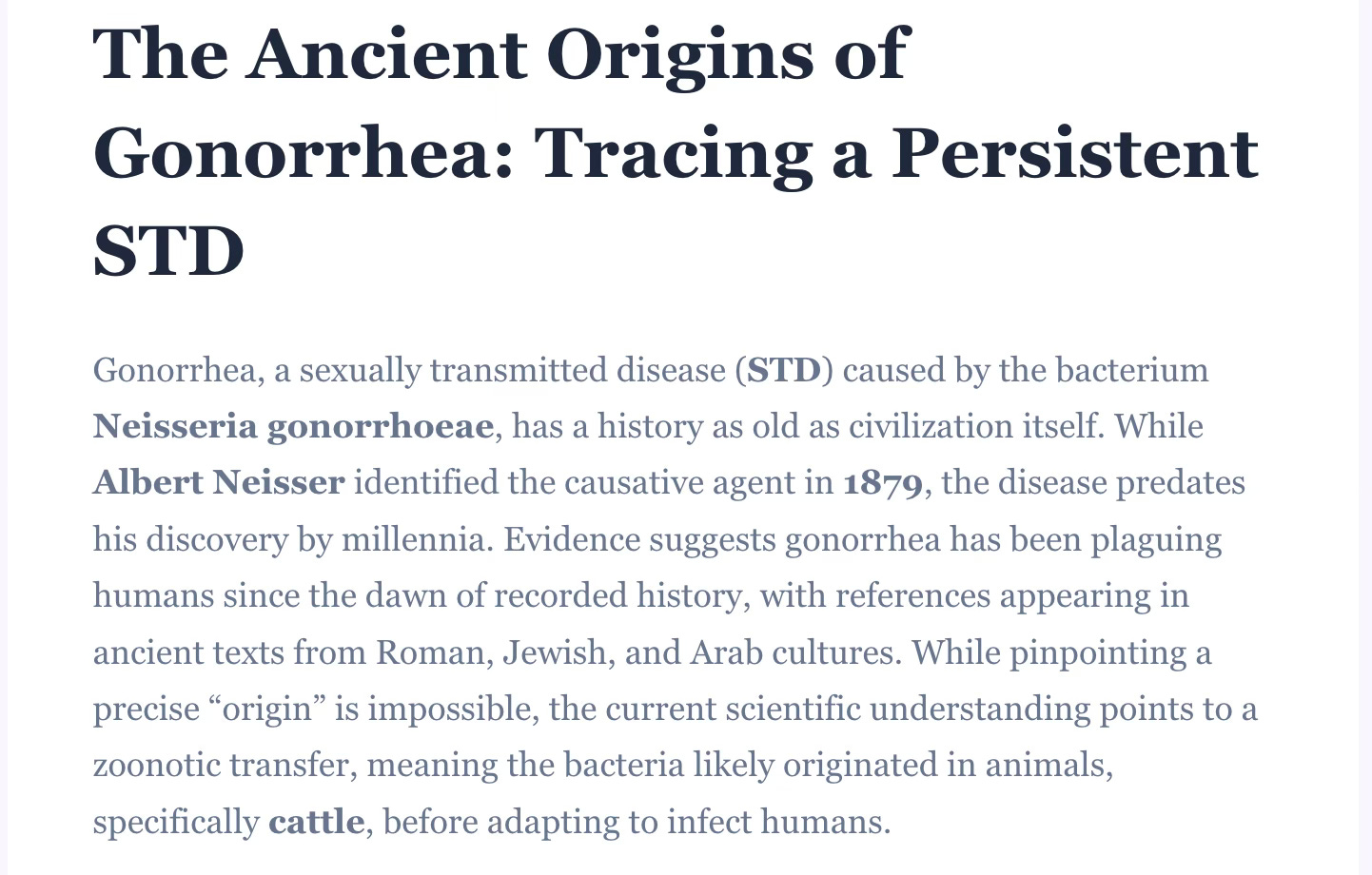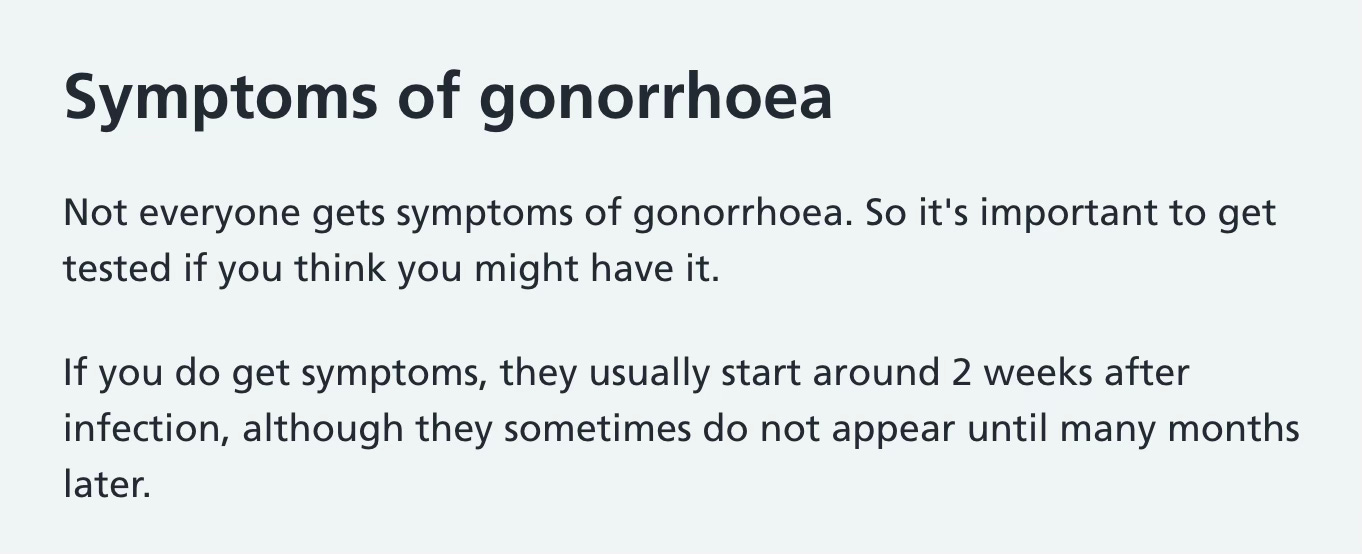I’ve recently received some new comments on my Substack article of almost 3 years ago, There’s No Such Thing As a Sexually Transmitted Disease - see link at the foot of this article. A number of those comments involve challenging my statement that ‘diseases’ are not sexually transmitted. However, one of the more strident commenters claimed I was sharing ‘dangerous misinformation’.
Obviously I do not accept that claim. On the contrary, I contend that it is the mainstream idea that ‘disease’ is or can be sexually transmitted that is the ‘dangerous misinformation’.
It’s clear that belief in the idea that diseases are caused by germs and can be transmitted between people, the idea on which the concept of STDs is based, impacts our lives in many ways. But it’s a belief that is based on a ‘theory’ that has never been proven and is long past its expiry date!
And that is the reason I continue to write - to expose and hasten the death of the failed paradigm that is the ‘germ theory’.
I have covered the topic of STDs a few times, including almost 2 years ago in my article, And on and on it goes… - see link at the foot of this article. However, I realise that my Substack has gained many new subscribers since then, for which I am really grateful, so it’s appropriate to revisit the topic, especially in view of recent efforts to further perpetuate fear about human intimacy in general and sexual intimacy in particular.
My focus this time is on gonorrhoea and was inspired by a 14th April BBC article entitled Potential new antibiotic for treating gonorrhoea that states,
“Gonorrhoea is one of the most common STIs in the UK and cases have been rising.”
The situation is not exclusive to the UK because, according to a ‘key fact’ in the July 2024 WHO fact sheet entitled Gonorrhoea (Neisseria gonorrhoeae infection),
“In 2020 there were an estimated 82.4 million new infections among adults globally.”
Note the use of the word ‘estimate’. It’s clear that the actual number of ‘new infections’ is not known, which raises, or at least ought to raise, serious questions over the use of the word ‘fact’. I’d also suggest questioning the source of these ‘facts’.
So why is gonorrhoea back in ‘the news’ at the moment? The answer can be found in the BBC article,
“Scientists believe they have found a new effective antibiotic for gonorrhoea, which could be one of the most promising in decades.”
The reason for the promotion of a ‘new treatment’ is stated to be because,
“Most of the cases were treatable, but there is growing concern that some strains can't be dealt with so easily.”
The words ‘growing concern’ in that article are linked to a UK government web page entitled Case-series of ceftriaxone-resistant Neisseria gonorrhoeae infections detected in England that was updated on 4th September 2024 and states,
“Neisseria gonorrhoeae, the bacteria which causes gonorrhoea, has developed resistance to every class of antibiotics used to treat it, and cephalosporins are the last remaining class of antibiotics available for use as empirical monotherapy.”
There are many problems with the above statement!
It should be noted that ceftriaxone, the current antibiotic used to treat gonorrhoea but no longer seems to be effective, is classed as a ‘cephalosporin antibacterial’.
The BBC article also refers to a new study, entitled Oral gepotidacin for the treatment of uncomplicated urogenital gonorrhoea (EAGLE-1): a phase 3 randomised, open-label, non-inferiority, multicentre study that was published in The Lancet on 14th April.
I can only access the abstract of the study article because I don’t have a paid subscription to The Lancet. The abstract nevertheless provides some useful information, such as this statement under the heading ‘Background’,
“Gepotidacin, a first-in-class, bactericidal, triazaacenaphthylene antibacterial that inhibits bacterial DNA replication, was shown to be efficacious and well tolerated in the treatment of uncomplicated urinary tract infections. We evaluated the efficacy and safety of gepotidacin for the treatment of uncomplicated urogenital gonorrhoea.”
What is particularly important to note are the final sentences of the ‘Findings’ section,
“The gepotidacin group had higher rates of adverse events and drug-related adverse events, mainly due to gastrointestinal adverse events, and almost all were mild or moderate. No treatment-related severe or serious adverse events occurred in either group.”
So adverse events are admitted to have occurred.
Despite the admission that the new drug produced a higher rate of adverse events recognised to be ‘drug-related’, the study paper nevertheless states in the ‘Interpretation’ section that,
“Gepotidacin demonstrated non-inferiority to ceftriaxone plus azithromycin for urogenital N gonorrhoeae, with no new safety concerns, offering a novel oral treatment option for uncomplicated urogenital gonorrhoea.”
To refer to the new drug as ‘non-inferior’ is a very strange way of saying that it was ‘no worse than’ the currently-used 2-drug combination.
But it clearly wasn’t better either.
I’d also question their use of the term ‘no new safety concerns’. Surely increased adverse events admitted to be directly associated with the use of this new drug should be a matter of concern, especially as the study merely demonstrates ‘non-inferiority’ with respect to clearing the infection.
And in case you were wondering who funded this study, see below!
So no conflict of interest at all in the results!! (Yes, that is sarcasm)
Back to the real problems with all of this.
The first and most important point to make is that there is no evidence that any bacterium is the cause of any disease, including those claimed to be ‘sexually transmitted’.
So let’s take a closer look at what gonorrhoea is claimed to be!
According to the WHO Gonorrhoea fact sheet,
“Gonorrhoea is a common sexually transmitted infection caused by a type of bacteria. It usually spreads through vaginal, oral or anal sex. Gonorrhoea is treatable and curable with antibiotics.”
In order to discover the ‘facts’ about gonorrhoea, I researched its alleged origin and found an article entitled Where did gonorrhea originate from? that begins with a rather interesting statement.
Note the use of the phrase ‘the current scientific understanding’, this is to convince people that there is real ‘science’ behind these claims; but sadly, that is not the case.
Note also the statement that pinpointing the origin is impossible!
There is, however, another theory, and a rather bizarre one, related to the source of STDs, because, according to the book, Human Kind,
“When humans began raising livestock, they also invented bestiality.”
The book does not seem to state whether humans passed ‘disease’ to animals or vice versa. Whatever the direction, this idea fails to demonstrate the real origin of the ‘disease’. How did it actually start? Who or what was the ‘first case’? These fundamental questions apply to all so-called ‘infectious diseases’.
The point to emphasise is that, contrary to the alleged ‘current scientific understanding’, there is zero evidence to support the idea that disease is transmissible between animals and humans, in whatever direction it may travel, through the transfer of bacteria (or so-called ‘viruses’).
As the web page about the origins of gonorrhoea states, the ‘causative agent’ was allegedly discovered in 1879. However, merely finding and identifying a bacterium and noting its association with a condition that has a particular label, does NOT prove that the bacterium is the cause of that condition - it merely demonstrates an association.
It’s the incorrect interpretation of such associations that has created all the problems we now experience with respect to the ‘germ theory’.
And this interpretation is stated as if it’s a proven ‘scientific fact’ by medical research studies. To demonstrate a typical example, a January 2019 study paper entitled Neisseria gonorrhoeae host-adaptation and pathogenesis, begins with the statement that,
“The host-adapted human pathogen Neisseria gonorrhoeae is the causative agent of gonorrhea.”
The authors of this paper provide no citations for their opening statement, despite the fact that everything that is written in the paper depends on this statement being correct. The entire study is based on this claim, and yet no documentary evidence is provided to support it. Which raises the question of whether the study authors actually checked their underlying assumption. I suspect not.
The most likely reason that no citation is provided for these opening statements, is that the idea is so firmly entrenched within their training that researchers accept it as ‘true’; because ‘everyone knows it’; a logical fallacy known as the ‘argument from popularity’. Consensus does not make something true!
As with so many ‘diseases’ I have researched, there are many anomalies with the claims relating to gonorrhoea. It is referred to as a ‘disease’, yet the definition of ‘disease’ includes reference to ‘signs and symptoms’. Nevertheless, a diagnosis of gonorrhoea may not always be accompanied by symptoms, as the NHS states,
For example, there are references to women who are said to have gonorrhoea yet are ‘asymptomatic’, as indicated by a 2020 study entitled Clinical presentation of asymptomatic and symptomatic women who tested positive for genital gonorrhoea at a sexual health service in Melbourne, Australia. In this study, asymptomatic women were assessed as having ‘gonorrhoea’ as the result of a test; in this instance, a ‘nucleic acid amplification test’ (NAAT).
According to the Kingsley Clinic web page, Understanding Nucleic Acid Amplification Test (NAAT): Benefits & Uses,
“By identifying the genetic material (DNA or RNA) of pathogens, NAAT offers unparalleled accuracy and speed compared to traditional diagnostic methods.
Again, the presence of nucleic acid does not ‘prove’ the presence of an ‘infection’; nor does the claim that the genetic material belongs to a ‘pathogen’ prove it to be the causal agent. Proof of pathogenicity must precede any claims about such an entity - yet that proof does not exist.
Some efforts to study gonorrhoea involve mice. According to the abstract of an online article entitled Female Mouse Model of Neisseria gonorrhoeae Infection, the accepted ‘protocol’ states that,
“Mouse models of infection are important tools in the study of infectious disease or host the development of products to prevent or treat infections.”
Yet, in the same article abstract is the following,
“The strict human specificity of N. gonorrhoeae limits the ability of experimental murine infection to mimic human infection.”
So is the mouse model useful for understanding human disease - or not?
I would point out that mice were not included in the list of animals said to have been domesticated and then subjected to bestiality. So why are mice used?
Although there are efforts to reduce animal testing in medical research, which is long overdue, the original reason for using mice is not because they are relevant to the study of disease in humans. Instead, it’s admitted to be because they are cheap and easy to handle.
But all of this is superfluous to the main question, which is: Has gonorrhoea ever been proven to be caused by a bacterium called Neisseria gonorrhoeae?
The answer - in case anyone is uncertain - is an emphatic no.
In fact, no matter what the alleged ‘disease’, the answer is still no. There is no evidence for the existence of any ‘pathogenic bacteria’.
And this is why it is so important to understand and appreciate the real role of bacteria in the body, which is to assist with the processes of elimination and healing. That bacteria become resistant to toxic antibiotics is something to be celebrated not feared. If bacteria were not able to resist these toxic antibiotics, they would die and our bodies would experience severe health problems due to the accumulation of toxins and waste matter.
Bacteria are not our enemies that need to be destroyed - that idea is based on the failed paradigm of the ‘germ theory’!
All claims about conditions referred to as ‘infectious diseases’ are based on creating fear and they require our compliance with interventions that are not merely inappropriate, but inherently harmful.
It is clear to me that one of the main purposes of all this fear-mongering about ‘infectious diseases’, whether sexually transmitted or not, is to keep us afraid of each other so we avoid physical contact of any description.
The solution, of course, is to refuse to comply with something that is the complete antithesis of what it means to be human; we are social beings who thrive on close connection and physical contact.
Dawn 🌹
There’s No Such Thing as a Sexually-Transmitted Disease
Thanks for reading Dawn’s Writings! Subscribe for free to receive new posts and support my work.
And on and on it goes….
It seems that many people wonder why the ‘no virus’ issue remains important now that the ‘pandemic’ is over.









Quick waffle by me and yes, you owe me for speaking up ... and embarrassing myself (lol).
I admit that I was sexually "active" when younger - and thrice I so thought I "caught a STI" ... which had the same or very similar effects "down below" and in my general wellness. The thing is, that the third time, it was impossible in my view, because I was on an offshore rig in the ME for a month, just with other blokes (NO stupid comments please), so started thinking what else it could have been. To be honest I had no idea, but when I finally went to the doctor and stated my story (crying emoji), he sent me for a a test to check for allergies.
Guess what ?; allergic to some petro-derivative products (and me in the O&G industry).
So underpants washed in a new "detergent" ..... TICK
and 3rd .... 3rd proved by Dr / hospital was the shower gel I used offshore - and the 2nd
; let us just state that I was told that I was reacting down below, to an unfamiliar girlie thing... but I assume she used products that contained the same petrochemicals in her wash / shower / whatever.
PEOPLE HAVE NO IDEA, how much of our daily life consumption "products" - contain stuff from petrochemical products. From medicine to shower gel, plastics to cosmetics, paint to FOOD and PRESERVATIVES. https://www.cpvmfg.com/news/examples-of-petrochemical-products-their-uses/
(the list is endless)
.....
PS 2 min video (sorry if I have posted before) = https://www.youtube.com/watch?v=WsqhwXfn2IU
Thanks a LOT for this, Dawn,
A friend of mine has reluctantly admitted the lack of evidence of SARS-CoV-2 existing, of cold and flu being transmitted, ..... but is adamant about STDs, because "My ex boyfriend infected me after running around" a long while ago I presented to her Dr Sam Bailey's work, and she claimed Dr Bailey obviously knew nothing about the topic, and clang to this assessment even after i informed her that Dr Bailey worked in this very field for several years. The notion of STDs has become for her a matter of personal honor.